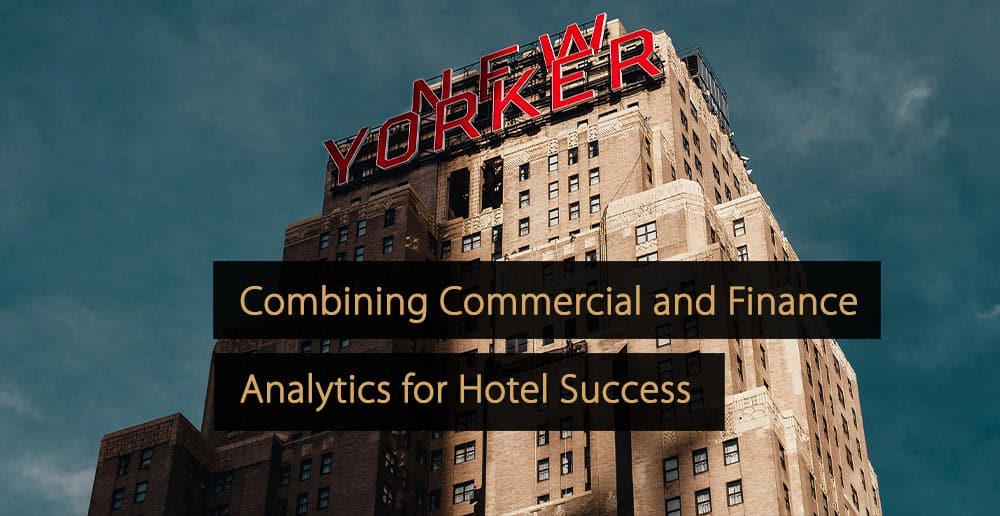Revenue management is a data-driven approach to predicting customer behavior, to optimize product pricing and availability to maximize revenue. It is especially useful in the hotel industry, because hotels have limited rooms available and experience varying demand levels. Several key performance indicators, or KPIs, should be tracked when carrying out a revenue management strategy. KPIs are quantifiable measures that allow a business to assess and compare performance over time. In this article, we look at three of the main revenue management KPIs.
Table of Contents:
- 1. ADR – Average Daily Rate
- 2. REVPAR – Revenue Per Available Room
- 3. GOPPAR – Gross Operating Profit Per Available Room
- Video: Example of Calculating Occupancy, ADR, RevPAR, and GOPPAR
- What Is the Importance of ADR, RevPAR and GOPPAR?
- Challenges for ADR, RevPAR & GOPPAR
- Strategies to Optimize ADR, RevPAR, and GOPPAR in Hotel Revenue Management
- More Revenue Management KPIs
1. ADR – Average Daily Rate
One of the most important KPIs for measuring a hotel’s performance against competitors, especially those of a similar size and in a similar location, ADR stands for “average daily rate”. Using this metric, hotel management can know the average price paid per room on a specific day and monitor trends over a longer time frame.
To work out your ADR, you simply divide room revenue by the number of rooms sold. So, for example, if you have a revenue of €20,000 and have sold 200 rooms, your ADR would be €100.
It should be noted that only available rooms for sale should be factored into your calculations. This means that you should not consider any rooms that staff members are using, nor should you include any complimentary rooms you have allocated to guests.
Find more detailed information about ADR in the article “What is ADR?”.
2. REVPAR – Revenue Per Available Room
Another extremely important key performance indicator for revenue management is REVPAR, or “revenue per available room”. Although it may seem similar at first glance to ADR, its use is somewhat different, as it can help tell you how successful you have been at filling the rooms in your hotel.
To calculate REVPAR, you simply divide your total rooms revenue by the total number of rooms available. So, if your revenue is €30,000 and you have 600 rooms available, your revenue per available room would be €50.
Perhaps the main thing to consider when calculating your revenue per available room is that only revenue generated by selling hotel rooms should be included. This means that you should not factor in other revenue streams, such as revenue from your restaurant or drinks sold at the bar.
Find more detailed information about REVPAR in the article “What is REVPAR?”.
3. GOPPAR – Gross Operating Profit Per Available Room
Finally, GOPPAR, or “gross operating profit per available room,” follows REVPAR quite nicely in that it is also a KPI measurement based on the number of rooms available rather than actual sales made. However, unlike REVPAR, when calculating GOPPAR, you consider all revenue sources.
To calculate your gross operating profit per available room, you must first work out your gross operating profit, which is gross revenue minus gross expenses. From there, divide your gross operating profit by the number of rooms available to be sold to guests.
The primary value of GOPPAR as a metric is that it allows you to see the bigger picture. After all, while rooms are the main revenue source in hotels, you will likely be making money from other areas, such as food and drink sales. Therefore, it allows managers to see how their business is performing overall.
For more detailed information about GOPPAR, like how you can calculate it, also have a look at “What is GOPPAR?”.
Video: Example of Calculating Occupancy, ADR, RevPAR, and GOPPAR
What Is the Importance of ADR, RevPAR and GOPPAR?
ADR, RevPAR, and GOPPAR are all important performance metrics within the hotel industry. Each provides different insights about a hotel’s financial success.
ADR, or average daily rate, provides a relatively simple snapshot of the average amount of rental revenue for an occupied room. Increasing this metric indicates that selling rooms will be more profitable. RevPAR looks at the amount of revenue generated per available room in the hotel, so it considers the occupancy rate. It is sometimes considered to be the most important metric because it explores a hotel’s overall revenue-generating success.
GOPPAR, as a performance metric, provides valuable information about overall operating efficiency, factoring in all of a hotel’s different revenue streams and operational costs. It is one of the most essential performance metrics for planning financial strategies and understanding overall financial health.
Continually tracking ADR, RevPAR, and GOPPAR and using them together can provide a comprehensive overview of hotel performance, factoring in room revenue, other revenue streams, costs, and occupancy rates.
Challenges for ADR, RevPAR & GOPPAR
Strategies to Optimize ADR, RevPAR, and GOPPAR in Hotel Revenue Management
Several useful strategies can help you improve your ADR, RevPAR, and GOPPAR metrics:
Refine Pricing Strategies
Your pricing strategies are crucial to ADR, RevPAR, and GOPPAR, so make sure you constantly review and refine them. This includes using dynamic pricing to adjust room rates based on demand, using promotions and discounts to ensure high occupancy rates, and reviewing the prices of auxiliary services to boost GOPPAR.
Enhance Online Presence and Distribution
The ADR, RevPAR, and GOPPAR metrics can also be optimized by boosting your online presence and distribution strategies. You may be able to boost visibility through marketing, search engine optimization, and working with other third-party platforms. It can also be a good idea to highlight additional services across OTAs.
Focus on Operational Efficiency
The GOPPAR metric, in particular, can be improved by strongly emphasizing operational efficiency and cutting costs. This can be achieved by minimizing waste, switching to more energy-efficient methods, maximizing the number of direct bookings generated to avoid commission fees, and ensuring as many rooms as possible are in use at all times.
Improve the Guest Experience
Finally, a great way to boost ADR, RevPAR, and GOPPAR in the long term is to focus on providing an incredible guest experience. This can have numerous benefits, such as encouraging recommendations and boosting demand or enhancing your reputation so you can charge higher prices and still fill your rooms.
Effective hotel revenue management is data-driven and requires tracking key performance indicators. Ultimately, tracking your ADR, REVPAR, and GOPPAR will put you in a better position to make pricing decisions, which can help you generate the maximum possible revenue from your hotel.
More Revenue Management KPIs
KPI stands for Key Performance Indicator. With KPI, you can measure and identify areas of success and failure and trends related to demand and customer behavior. Besides ADR, REVPAR, and GOPPAR, other important Revenue Management KPIs are:
- What Is RevPOR?
- What is an Occupancy Rate?
- What does EBITDA stand for?
- NRevPAR Clearly Explained!
- What is ARPA?
- What is TRevPar?
- RevPAR versus GOPPAR
More Tips to Grow Your Business
Revfine.com is the leading knowledge platform for the hospitality and travel industry. Professionals use our insights, strategies, and actionable tips to get inspired, optimize revenue, innovate processes, and improve customer experience.Explore expert advice on management, marketing, revenue management, operations, software, and technology in our dedicated Hotel, Hospitality, and Travel & Tourism categories.
This article is written by:
Hi, I am Martijn Barten, founder of Revfine.com. With 20 years of experience in the hospitality industry, I specialize in optimizing revenue by combining revenue management with marketing strategies. I have successfully developed, implemented, and managed revenue management and marketing strategies for individual properties and multi-property portfolios.











Leave A Comment